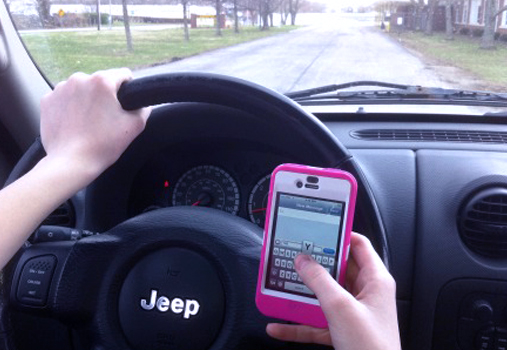An end to texting while driving
By Cory Nourie
I’m concerned about an epidemic which has the potential to impact every single person in Delaware: distracted driving, or, more precisely, texting and driving. A current commercial is particularly powerful. A mom is busy checking how many “likes” her daughter’s Facebook post has received … when she crashes. The message is “it can wait.”
It truly can. I’m frightened by the number of drivers I’ve seen who aren’t watching the road at any given moment. If one looks up the statistics, it’s downright scary. The average person looks at a cell phone for five seconds while responding to a text. Those five seconds are how long it takes to drive the length of a football field at 55 mph. Imagine doing that blindfolded and it seems absurd. But drivers have no problem typing in their passcode and then texting or checking their social media account—all while essentially blindfolded.[1]
What, then, can we do? Delaware and 45 other states have bans on handheld cell phone use, and fines for getting caught, yet that threat doesn’t seem to disincentivize drivers into not texting and driving. Can the police step up patrols? Sure, but would it really matter? If a person is texting and driving and there’s no one there to issue a citation, does that make it any less dangerous? No. The National Safety Council reports that cell-phone use while driving leads to 1.6 million crashes each year. Figured another way, it’s involved in 26 percent of all crashes, each year. Moreover, the National Highway Traffic Safety Administration (NHTSA) notes that nine people die every day as a result of texting while driving. Here’s what I’m thinking: let’s open a conversation with our families about this. If you’re a parent, tell your child it’s ok to remind you to not reach for your phone while at the wheel. Be comfortable telling your friend to not touch her phone while she’s driving. If you carry a purse, keep your phone in your purse on the floor while driving. Get into the habit of putting your cell phone in the glove box or console when you get in the car. For decades we survived without being able to be reached instantaneously, and your family and friends would rather you be unreachable while driving than injured or killed while trying to respond to their call or text.
I’m considering starting a movement to hand out little signs that say, “I saw you texting and driving. Please don’t. It can wait.” So, if you pull up to someone at a stop light or in a parking lot, you can just flash the sign to remind them. We’re all in this together, right? Don’t we have an obligation to look out for one another, while protecting ourselves? As a driver, you have the potential to impact me and my family as automobile occupants or pedestrians. Your decision to respond to that text or check how your friend is doing on CandyCrush or post the selfie can produce a permanent life-changing result. Accidents cause a literal chain reaction and the impact of injury or death is far-reaching, not just affecting those immediately in the vehicle(s) but their family, friends, school and community. According to the NHTSA, 1,153 people are injured daily in crashes that are reported to involve a distracted driver; that’s 420,845 injured people every year. Some of those injuries heal, while others cause lifelong disabilities; all of which could have been prevented. It’s truly not worth it.
Will my little sign help? How would you feel if someone brought your texting and driving to your attention? Will people feel like I’ve overstepped boundaries? They may. But if I don’t say something to them, who will? One of my favorite quotes from Einstein is, “The world is a dangerous place, not because of those who do evil, but because of those who look on and do nothing.” I implore all of you reading to not “look on and do nothing.” If you see someone texting and driving, stop them while you have the chance. You may just save a life, theirs or someone else’s. Future generations thank you.
[1] http://mcsac.fmcsa.dot.gov/documents/DriverDistractionStudy.pdf



Comments